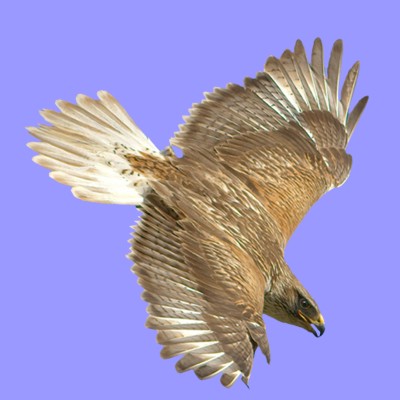Ferruginous Hawk, Buteo regalis
The Ferruginous hawk is represented in the raptor collection of Rancho Texas Park in Lanzarote. It is a large bird of prey endemic to the interior parts of North America. It usually migrates to Mexico. The Buteo regalis is the largest of the buteos and is often mistaken for an eagle.
 Main characteristics
Main characteristics
As with all birds of prey, the female is larger than the male. Size is the main difference between both sexes. Length ranges around 58cm with an average wingspan around 142cm and weight from 1 to 2kg. Adults have long broad wings and a broad grey, rusty or white tail. There are two colour forms: light morph birds are rusty brown on the upper parts and pale on the head, neck and underparts with rust on the legs and some rust marking on the underwing. The upper wings are grey. Dark morph birds are dark brown on both upperparts and underparts with light areas on the upper and lower wings.
The Ferruginous Hawk is native to the open, arid grasslands, prairie and shrub steppe country of North America. The species is one of the most adaptable nesters of all raptors, and will use trees, ledges, rock or dirt outcrops, the ground, haystacks, nest platforms, power poles, and other man-made structures. The Ferruginous Hawk maintains minimum distances of approximately 3km from other nesting raptors. Breeding season occurs between March and May. The females generally lay 3 or 4 eggs, though clutches of up to 6 are also possible. The young fledge around June or July.
The Ferruginous Hawk primarily hunts small to medium-sized mammals but will also take birds, reptiles, and some insects.
The species is classified as a “Near Threatened Species” on the IUCN Red List 2008.
Ferruginous Hawk, Buteo regalis
Facts:
How are they? The Ferruginous Hawk is the largest of the buteos and therefore often mistaken for an eagle. Average body length ranges from 50-66cm, and the wingspan from 134-152cm. Females are generally bigger than males. Two colour forms exist: light morph birds are rusty brown on the upper parts and pale on the head, neck and underparts with rust on the legs and some rust marking on the underwing. Dark morph birds are dark brown on both upperparts and underparts with light areas on the upper and lower wings.
Where do they live? Open, arid grasslands, prairie and shrub steppe country.
How is the species geographically distributed? The interior and western parts of North America: from southern Canada to northern Mexico.
What do they feed on? On medium-sized mammals, birds, reptiles and insects.


